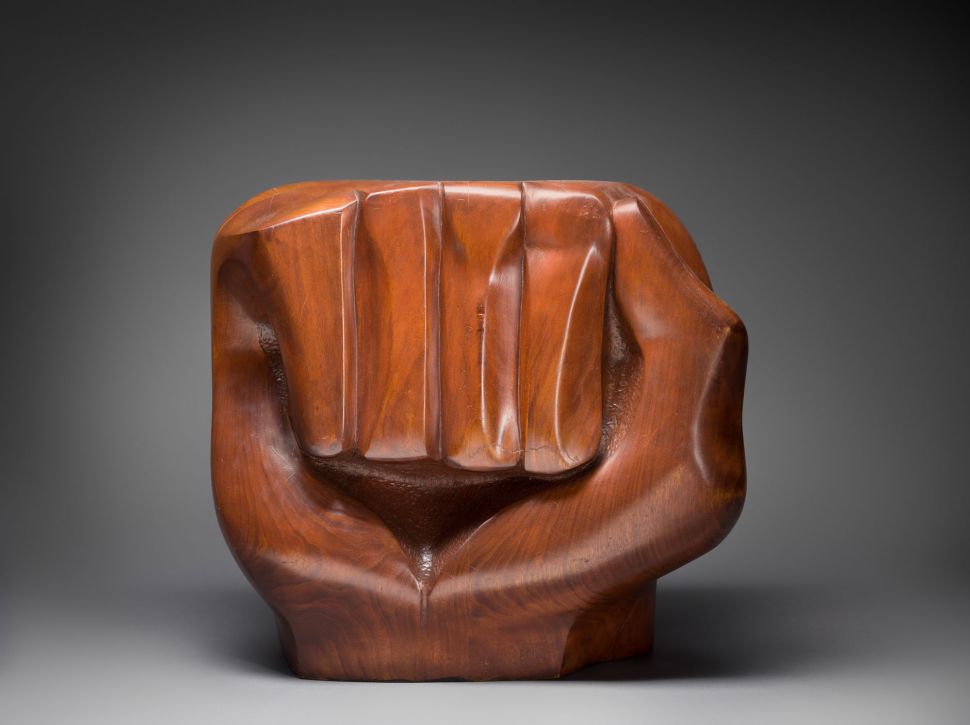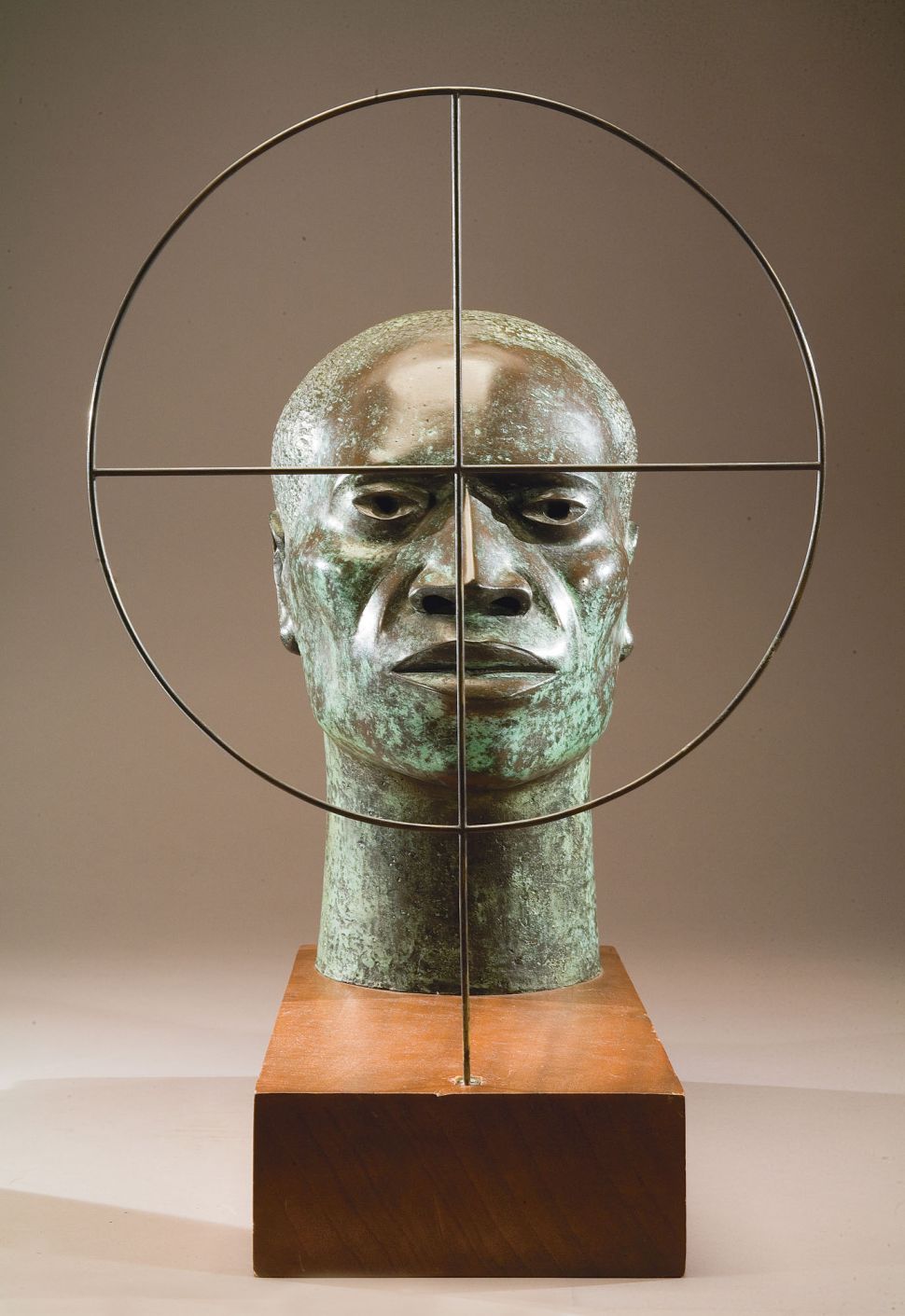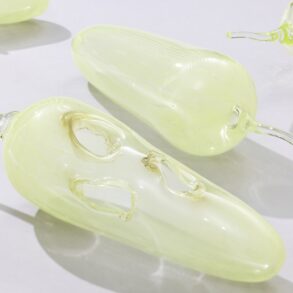
If there’s one overlooked woman artist in American art history everyone should know about, it’s Elizabeth Catlett. Catlett was a badass artist, a political activist and a feminist. She is known for her prints and her sculptures and her relentless social justice advocacy. Born in Washington, D.C. in 1915, she grew up during the Great Depression, witnessing racial violence, inequality and political turmoil, and perhaps consequently, her activism is intertwined with her art: there are raised fists, works that speak to the Black-American experience and lithographs of Black and Mexican women—she moved to Mexico in 1946 and lived there until she died in 2012 at age 96.
Catlett’s work was the subject of more than fifty solo exhibitions during her lifetime. Now, a new retrospective of the artist is opening at the Brooklyn Museum on September 13. “Elizabeth Catlett: A Black Revolutionary Artist and All That It Implies” features over 150 pieces that pay tribute to this activist artist who deserves to be more widely known. The exhibition will close in Brooklyn in January, then reopen in the National Gallery of Art in Washington on March 9 before traveling to the Art Institute of Chicago in August.
According to Catherine Morris, one of the show’s curators, Catlett made major contributions to art history that have only lately been more widely recognized. “She has been overlooked in mainstream art world circles,” she told Observer, “while being fully celebrated in the communities that were most important to her, such as those of Black Americans, who often were not included in the mainstream art world at the time.”

Catlett dedicated her life to social justice. After living in Washington and New York City and then settling in Mexico in 1947, where she married artist Francisco Mora, had three children and taught art for over sixty years. Her unique outlook and tenacity fused together the strength and struggles of Black Americans and the Mexican communities she first encountered In Mexico City while on a printmaking fellowship where she created a series of fifteen linocuts for her series, “The Black Woman,” which includes portraits of Sojourner Truth, Harriet Tubman and Phillis Wheatley.
That series was inspired by her time with Taller de Gráfica Popular (TGP), an artist print collective founded in 1937 and focused on advancing social causes. “It was built from the tenets of the Mexican Revolution, one of which was the belief that art could play a central role in fostering political awareness, education, and action,” said Morris. “The lessons of the TGP, along with Catlett’s social and political growth through the cultural and social circles she participated in in Washington, Chicago and New York, form the backbone of her art and activism.”
SEE ALSO: The Phillips Collection Looks at Blackness in Contemporary American Collage
Much later, Catlett would eventually become a Mexican citizen, but she never let go of her Black American identity. As she told Ebony in 1970, “I am inspired by Black people and Mexican people, my two peoples.” The name of the Brooklyn Museum exhibition was inspired by a talk Catlett gave in 1970 during which she said, “I have been, and am currently, and always hope to be a Black Revolutionary Artist and all that it implies.”




Highlights of the exhibition include Catlett’s prints, sculptures and early paintings, as well as works on paper and early artworks made during her time at Howard University in Washington, D.C. Taken together, the works offer “deeper insight into Catlett’s overall career and her methods and examinations of art history, modernism and representing Black women and their lived experience,” according to Morris.
Among the rarest items in the show is a sketchbook from around 1944 that has never been exhibited. “Over the course of dozens of pages, you can see Catlett moving back and forth between naturalism and abstraction, proving that the signature social realist style that we know her for today was not inevitable but an aesthetic choice intended to align with her deeply held political beliefs,” co-curator Dalila Scruggs told Observer.




Catlett was proactive about creating works that would be installed in public places like libraries and parks. She wanted people to encounter art where they already were versus having to go to a museum or gallery, said Morris. “For Catlett, art was for everyone and should be accessible—not just in form and content, but also in the opportunities to encounter and reflect on it.”
Her art was also overtly political. Mexican women didn’t gain suffrage rights until 1953, and “Catlett created posters as an active member of the proto-feminist Unión Nacional de Mujeres Mexicanas, demanding greater rights for women and their children,” said Scruggs. Catlett used a raised fist in her 1968 sculpture, Black Unity, as well as Homage to My Young Black Sisters from the same year, partly inspired by the 1968 Olympics held in Mexico City during which winning African American athletes Tommie Smith and John Carlos famously raised their fists in protest.
“Ultimately, Catlett is Mexican history—and the proliferation of exhibitions in Mexico about Catlett, along with her husband Francisco Mora, are overdue recognition of this fact,” added Scruggs. Yet the artist’s work is relevant today in a way that transcends a specific geography. “History can show us the legacies we are building on in our current world. She offers us almost a century of proof that personal commitment and the prioritizing of community can write history. It can also make us feel less alone.”




This post was originally published on this site be sure to check out more of their content







